![]()
![]()
![]()
Use LEFT and RIGHT arrow keys to navigate between flashcards;
Use UP and DOWN arrow keys to flip the card;
H to show hint;
A reads text to speech;
47 Cards in this Set
- Front
- Back
|
Two broad categories of ingredients |
Forages and Concentrates |
|
|
What are forages? |
- hay, silage, straw, high fibre by-products - lower in energy and not as digestible - source of fibre, protein, macro minerals, energy |
|
|
What are concentrates? |
- grains, oilseeds, protein sources, fats and oils, mineral and vitamin supplements, additives - high energy, highly digestible ingredients |
|
|
Perennial grasses |
- bromegrass, fescue, orchardgrass, timothy - can be grazed as pasture or harvested for hay or silage - can be native or tame |
|
|
Cereals |
- corn, barley, oats, rye - harvested as silage or green feed |
|
|
Legumes |
- alfalfa, clover, peas, beans - harvested as hay or silage - fix nitrogen into the soil |
|
|
Why is the stage of maturity important to consider when feeding forages? |
- the intake potential and nutrition quality is largely dependent on what stage of growth they're in - older plants and longer stems and smaller leaf proportion. Their fibre (lignin) content increases and CP decreases (all bad things!). Decreased digestibility and not as tasty for the cows, so their intake goes down |
|
|
Introduced/tame grasses have higher growth rates in the... |
cool season |
|
|
cool season, introduced grass examples |
bromegrass, fescue, orchardgrass, timothy |
|
|
Native grasses have higher growth rates in the... |
warm season and cool season |
|
|
warm season native grasses |
buffalograss, cordgrass, switchgrass |
|
|
cool season native grasses |
wheatgrass, needlegrass, canarygrass |
|

what grass is this? |
Smooth Bromegrass - a perennial cool season grass - drought hardy - survives extremes in temperature |
|
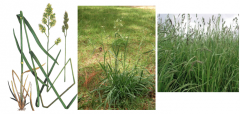
What grass is this? |
Orchardgrass - bunch-type, tall-growing, cool-season perennial grass - tolerant to shade, fairly drought resistant with moderate winter hardiness |
|
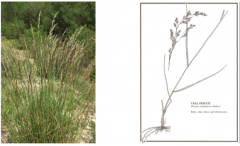
what grass is this? |
Tall Fescue - best adapted cool-season grass - accumulates growth/stockpiles so you can graze it in the fall and winter |
|
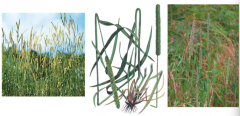
what grass is this? |
Timothy - cold-hardy, short-lived bunchgrass - palatable, cows love to eat it! - not drought-tolerant. Wants irrigation and fertilizer to do well |
|
|
Examples of cereal crop forages |
barley, corn, oats, rye, and triticale (a wheat-rye hybrid) |
|
|
Barley |
- grows best in well drained, fertile soils - awns on the stems are spikey and can decrease palatability - 2-row and 6-row varieties |
|
|
Corn |
- highly palatable - high digestible energy but low in digestible protein |
|
|
Rye |
- good pasture crop because of high productivity - becomes unpalatable with maturity |
|
|
Oats |
- can be grazed or hayed or silaged |
|
|
Triticale |
- wheat/rye cross - dairy cows don't like it, so it's not very popular |
|
|
Grass maturity stages (2) |
vegetative phase, transition phase, and reproductive phase |
|
|
What is the "boot stage"? |
in the reproductive phase just before heading out, when the developing seed head begins to push through the sheath of the flag leaf. Lasts a week to ten days |
|
|
What is the milk stage? |
When the grain kernels on the head develop. A white, milky fluid appears when you squeeze a kern. Lasts ten days |
|
|
What is "soft dough"? |
when the kernel is well formed and only filled with starch. No milky fluid comes out, only a rubbery doughy substance. Lasts a week to ten days |
|
|
What is "milk line"? |
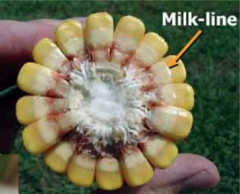
In corn, after kernels are dented a white line appears across the kernel opposite the embryo side. This line advances down toward the cob with maturity and dry down |
|
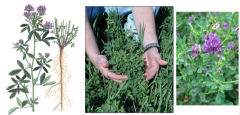
What legume forage is this? |
Alfalfa - a perennial legume that can survive in hot and cold climates - in silages and hay - can't withstand drought for long periods. Can't tolerate acidic soil or high water table - can cause frothy bloat in ruminants |
|
|
Alfalfa Maturity Stages (4) |
1. Vegetative - growth of stems and leaves 2. Bud - buds are green immature flowers, no purple flower petals 3. Early Bloom - one node with one open flower 4. Late Bloom - More nodes with open flowers |
|
|
Most digestible stage of alfalfa growth |
Pre-bud is most digestible (66.8%) Late-bloom and mature are least digestible (57.5% and 55.8%) |
|
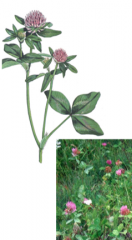
What plant is this? |
Red Clover - can be good alternative to alfalfa for silage - alfalfa will outyield it under ideal conditions - where alfalfa winterkill is a problem, red clover better tolerates bad drainage and low pH soil. - similar feed quality to alfalfa - Difficult to cure as hay without being dusty or moldy |
|
|
Moisture content of hay |
15% or less |
|
|
Steps for haying (4) |
mowing/swathing drying raking baling |
|
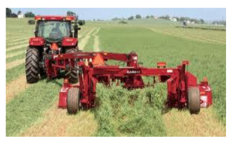
What step is this? |
Mowing - Mowers have rollers that crimp the stems which speeds up drying. Swathers don't crimp. - Mowing should be done in afternoon when sugar concentration is highest - Dessicants can be sprayed on to promote drying |
|

What step is this? |
Raking - rolls hay over so the bottom of the windrow can dry out |
|
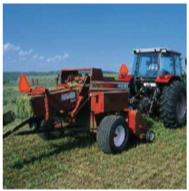
What step is this? |
Baling - can be small squares, large squares, or round bales |
|
|
What stages of maturity are ideal for haying for alfalfa and grasses? |
alfalfa: early bloom stage grasses: boot stage |
|
|
Nutrient losses with haymaking |
- cellular respiration (4-15% of initial DM may be lost) - leaf shattering - rain damage - vitamin A losses - heating: forms Maillard products - stacking high-moisture hay can cause spontaneous combustion and fires! |
|
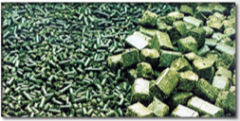
What is this? |
Dehydrated Alfalfa - "dehy" - alfalfa is chopped green, partially wilted, then dried in rotating drums - minimal nutrient loss - bright green with high Vit A activity |
|
|
What is Green Feed? |
cereal crops cut at an immature stage, then dried and baled or left on the field for swath-grazing |
|
|
Harvesting Stage to make green feed for barley, oats, wheat, fall rye, and triticale |
barley: milk to soft dough oats: early to late milk wheat: milk to soft dough fall rye: boot to heading triticale: heading to late milk |
|
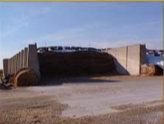
What goes in here? |
Silage - forage conserved by anaerobic fermentation - plant material is chopped and packed to exclude oxygen - lactic acid depresses pH to 4 - bacterial growth is inhibited |
|
|
Why is the moisture content of silage important? |
Too dry: exclusion of oxygen is difficult and moulding/heating occurs. Not enough fermentation will occur
Too wet: Clostridial fermentation may produce butyric acid, lowering feed intake
DM should be 30-35% (for corn silage 32-35%) |
|
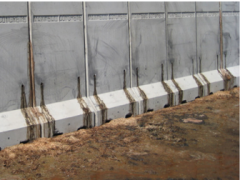
What is this and why is is bad? |
Silage effluent (wet silage) - Wet silage is bad because when its piled, pressure squeezes out water and many soluble sugars, proteins, and minerals are lost |
|
|
Keys to making good silage: |
- harvest crop at optimum maturity - wilt crop as quickly as possible to desired DM content to preserve nutrients and promote good fermentation - chop forage to optimal size (1/2"-1") - use silage additive to promote efficient fermentation - rapidly pack to exclude air, pack tightly - seal silo or pit ASAP after filling - prevent air penetration during storage and feed-out |
|
|
Why use silage inoculants? |
- they add fast growing homofermentative lactic acid bacteria that dominate fermentation, giving higher quality silage - speed up fermentation and improve shelf life - lower pH, acetic acid, butyric acid, and ammonia but have higher lactic acid than non-treated silage |
|
|
Filling silos |
- fill in progressive wedge, packed in 15-20 cm layers - packing density of 225 kg DM per cubic meter |

